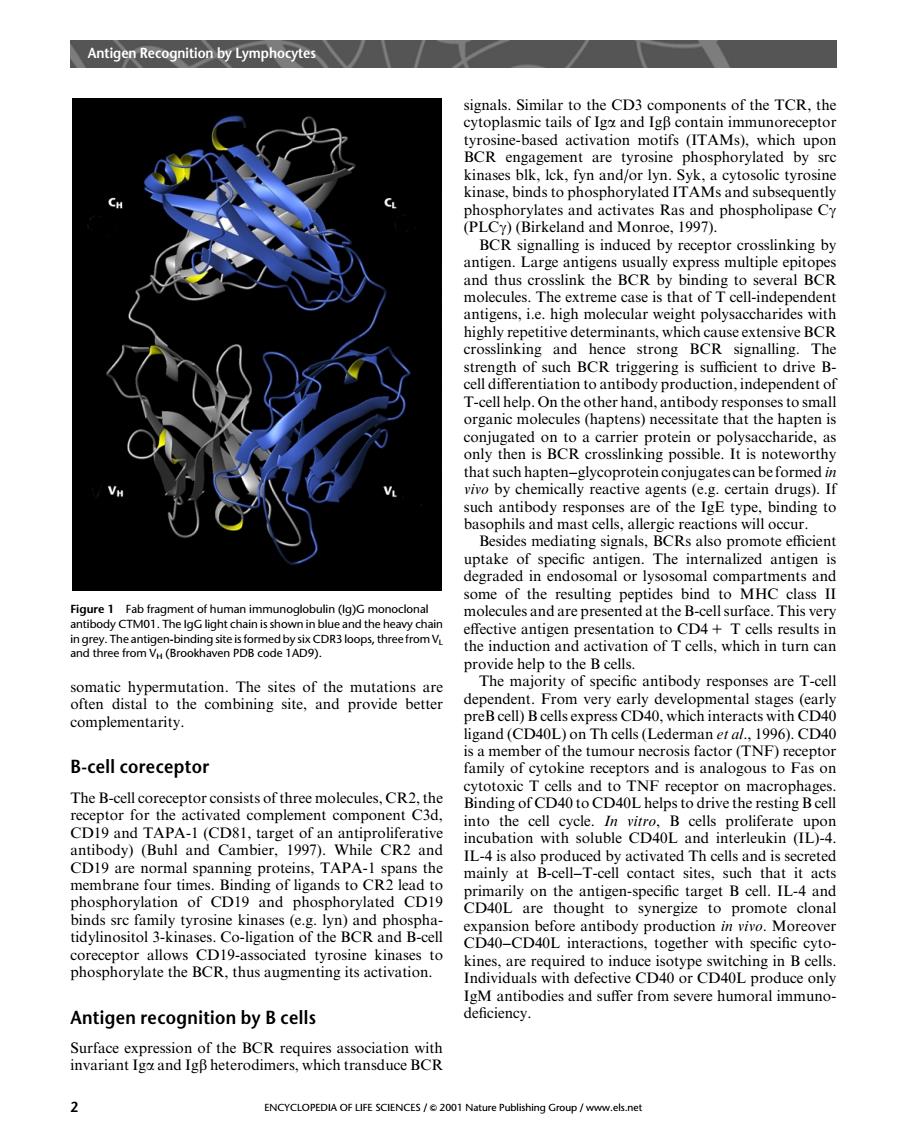正在加载图片...

AntigeoLymphoytes signals.Similar to the CD3 components of the TCR.the cytoplasmic tails of Iga and IgB contain immunoreceptor whic upon lck.fy kinasbindstoAMsnubseun slinking by anthe BCR yndingto ue The ms isthtofth ens,i. high mo and ermin cell differentiation to antibody production,independento T-celhelp. s【0sma L ivo by che alle of ing to Besides mediating signals,BCRs also promote eficient uptake of specific antigen.The internalized antigen is n endo ment unoglobulin (Ig)G monoclonal This ver ffective antigen presentation to CD4+T cells results in the induction and activation of T cells.which in turn can somatic hypermutation.The sites of the mutations are antibody resp are T-cell ly de often distal to the combining site,and provide better complementarity. reB cell)Bcells express CD40,which interacts with CD40 igand(CD40L)on Th cells (Lederman et al. B-cell coreceptor e tumour necros The xic T cells and to TNE ement compo Binding of CD40to CD40L helps to drive the resting Bcell CDi9 and TAPA-1 (CD81.target of an antiproliferative nto the antibody)(Buhl and Cambier.1997).While CR2 and ntere al spanning proteins.TAPA. the though clonal 240CD4 fore antibody prod oreove are requi ad to induc g in B ceu Individuals with defective CD40or CD40L produce only Antigen recognition by B cells eaghotiesnduieroamoeehmnoalimmno imn2aae8ebCRhaimaieCR ENCYCLOPEDIA OF LIFE SCIENCES/2001 Na ublishing Group/www.els.netsomatic hypermutation. The sites of the mutations are often distal to the combining site, and provide better complementarity. B-cell coreceptor The B-cell coreceptor consists of three molecules, CR2, the receptor for the activated complement component C3d, CD19 and TAPA-1 (CD81, target of an antiproliferative antibody) (Buhl and Cambier, 1997). While CR2 and CD19 are normal spanning proteins, TAPA-1 spans the membrane four times. Binding of ligands to CR2 lead to phosphorylation of CD19 and phosphorylated CD19 binds src family tyrosine kinases (e.g. lyn) and phosphatidylinositol 3-kinases. Co-ligation of the BCR and B-cell coreceptor allows CD19-associated tyrosine kinases to phosphorylate the BCR, thus augmenting its activation. Antigen recognition by B cells Surface expression of the BCR requires association with invariant Iga and Igb heterodimers, which transduce BCR signals. Similar to the CD3 components of the TCR, the cytoplasmic tails of Iga and Igb contain immunoreceptor tyrosine-based activation motifs (ITAMs), which upon BCR engagement are tyrosine phosphorylated by src kinases blk, lck, fyn and/or lyn. Syk, a cytosolic tyrosine kinase, binds to phosphorylated ITAMs and subsequently phosphorylates and activates Ras and phospholipase Cg (PLCg) (Birkeland and Monroe, 1997). BCR signalling is induced by receptor crosslinking by antigen. Large antigens usually express multiple epitopes and thus crosslink the BCR by binding to several BCR molecules. The extreme case is that of T cell-independent antigens, i.e. high molecular weight polysaccharides with highly repetitive determinants, which cause extensive BCR crosslinking and hence strong BCR signalling. The strength of such BCR triggering is sufficient to drive Bcell differentiation to antibody production, independent of T-cell help. On the other hand, antibody responses to small organic molecules (haptens) necessitate that the hapten is conjugated on to a carrier protein or polysaccharide, as only then is BCR crosslinking possible. It is noteworthy that such hapten–glycoprotein conjugates can be formed in vivo by chemically reactive agents (e.g. certain drugs). If such antibody responses are of the IgE type, binding to basophils and mast cells, allergic reactions will occur. Besides mediating signals, BCRs also promote efficient uptake of specific antigen. The internalized antigen is degraded in endosomal or lysosomal compartments and some of the resulting peptides bind to MHC class II molecules and are presented at the B-cell surface. This very effective antigen presentation to CD4 1 T cells results in the induction and activation of T cells, which in turn can provide help to the B cells. The majority of specific antibody responses are T-cell dependent. From very early developmental stages (early preB cell) B cells express CD40, which interacts with CD40 ligand (CD40L) on Th cells (Lederman et al., 1996). CD40 is a member of the tumour necrosis factor (TNF) receptor family of cytokine receptors and is analogous to Fas on cytotoxic T cells and to TNF receptor on macrophages. Binding of CD40 to CD40L helps to drive the resting B cell into the cell cycle. In vitro, B cells proliferate upon incubation with soluble CD40L and interleukin (IL)-4. IL-4 is also produced by activated Th cells and is secreted mainly at B-cell–T-cell contact sites, such that it acts primarily on the antigen-specific target B cell. IL-4 and CD40L are thought to synergize to promote clonal expansion before antibody production in vivo. Moreover CD40–CD40L interactions, together with specific cytokines, are required to induce isotype switching in B cells. Individuals with defective CD40 or CD40L produce only IgM antibodies and suffer from severe humoral immunodeficiency. Figure 1 Fab fragment of human immunoglobulin (Ig)G monoclonal antibody CTM01. The IgG light chain is shown in blue and the heavy chain in grey. The antigen-binding site is formed by six CDR3 loops, three from VL and three from VH (Brookhaven PDB code 1AD9). Antigen Recognition by Lymphocytes 2 ENCYCLOPEDIA OF LIFE SCIENCES / & 2001 Nature Publishing Group / www.els.net